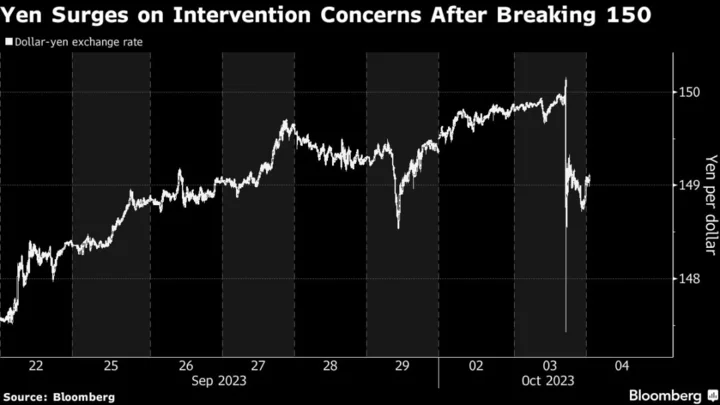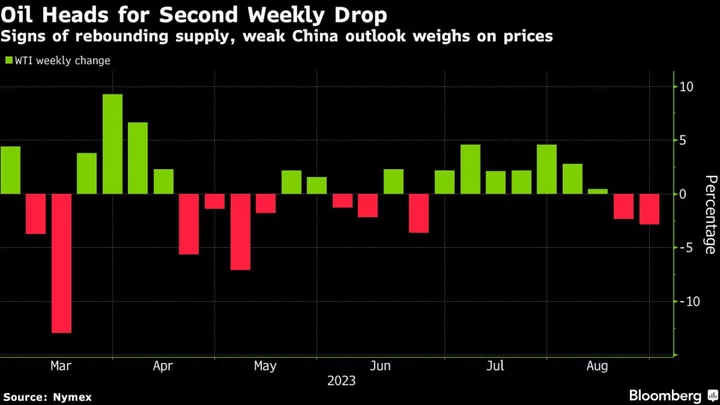The yen surged from the weakest levels in a year amid speculation that Japanese officials were acting to slow the currency’s slide.
Japan’s currency reached 150.16 per dollar on Tuesday in New York trading, its cheapest since multi-decade lows set in October 2022, as a report showing US labor demand remains resilient pushed Treasury yields higher.
The yen then soared nearly 2% in a matter of seconds to as strong as 147.43. It traded at around 149 early the Tokyo session, with traders selling yen again as US yields rose to the highest level since 2007.
“We won’t know until official confirmation, but it sure feels like it,” Bipan Rai, CIBC’s global head of foreign-exchange strategy, said of the possibility Japanese officials had acted.
An official with Japan’s Ministry of Finance had no comment on whether Japan had intervened on the yen.
Intervention Chatter
About 83,000 yen futures contracts traded in the half hour after the release of the US jobs data, around 25 times the average volume seen since May over such a time-frame. The increase is a sign that traders who were leaning heavily toward yen losses were forced to cover those bets as it strengthened suddenly.
While the abrupt moves fueled chatter across Wall Street about possible intervention, analysts also pointed to other explanations, such as standing orders to sell dollars at the 150 level because of the threat of official action.
That was the view of Marc Chandler, chief market strategist at Bannockburn Global. “It could be intervention, but I doubt it,” he said.
Others suggested the trigger may have been Japanese authorities checking exchange rates with banks — a move often seen as a prelude to further official action.
The Bank of Japan “may have just executed a drive by and ‘checked prices’ with dealers,” said Shaun Osborne, chief foreign-exchange strategist at Scotiabank in Toronto. “If it was intervention, they will be disappointed that we are back to 149 or so very quickly.”
Soaring Dollar
The dollar has been on a tear for the last two-and-a-half months as investors digest the likelihood that the Federal Reserve will keep interest rates higher for longer to tame inflation. On Tuesday, the Bloomberg Dollar Spot Index climbed to the strongest since November.
At the same time, traders have been testing Japanese policymakers’ commitment to ultra-easy monetary policy amid robust inflation, putting pressure on both the yen and the country’s government bonds.
A weak yen makes imports more expensive for Japan, potentially pushing up prices. It also helps the nation’s exports by making them less costly overseas.
Treasuries continued to sell off Tuesday. The yield on 30-year bonds surged to the highest level since 2007 after a report showed US job openings unexpectedly increased in August.
Policy Hurdle
In Japan, Masato Kanda, the top currency official at the Ministry of Finance, has said he’s keeping in close contact with his US counterparts, with both sides in agreement that excessive currency moves are unwelcome. Finance Minister Shunichi Suzuki warned about the currency fluctuations for six days in a row through Tuesday. He said on Tuesday he won’t judge the possibility of FX intervention on currency levels but through volatility.
“For the intervention to be effective, it would need to be complemented by a change in policy, i.e. hike in rates and/or complete removal of YCC,” Paresh Upadhyaya, director of currency strategy at Amundi in Boston, said via email, in reference to the Bank of Japan’s yield-curve control.
“If we get to 155 then they may have to drop their benign-neglect attitude towards intervention into something with more fortitude,” he said.
The first intervention by Japan last year came when the yen weakened to 145.90 in September. The country spent around $65 billion in total to support the yen in three occasions in September to October, the first such intervention in 24 years.
Last October’s lows were the weakest for the Japanese currency since 1990.
--With assistance from Paul Jackson and Masaki Kondo.
(Updates with the latest yen level in the third paragraph.)
Author: Carter Johnson, Anya Andrianova and Robert Fullem









